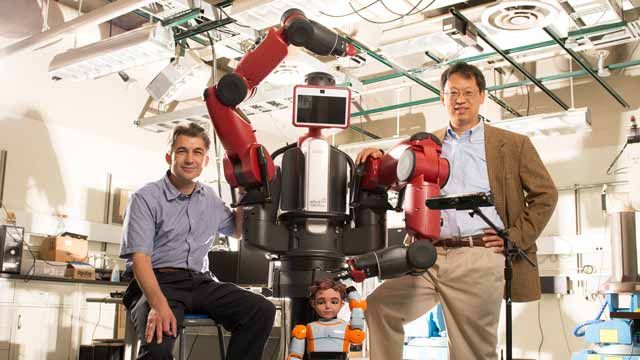Rensselaer Polytechnic Institute Speeds the Development of Robotic Control Systems
“A primary benefit of using MATLAB and Simulink in our research is the ready availability of toolboxes for computer vision, image processing, and control system development. All the tools we need are in one environment that is easily integrated with other software for robotics and automation systems.”
Challenge
Solution
Results
- Project continuity maintained across student teams
- Development time shortened
- Instant feedback provided

The robotics program at Rensselaer Polytechnic Institute (RPI) spans undergraduate, graduate, and faculty research projects as well as undergraduate classes.
RPI students and faculty researchers use MATLAB® and Simulink® to rapidly develop and test robot control systems, both in Robotics 1, a course in which students learn control design for robots, and on cutting-edge research projects, including a mobile robot powered by hydrogen fuel cells.
“With MATLAB and Simulink, students and researchers can try out a new idea, see how it works, and then quickly make changes,” says Dr. John Wen, head of the Industrial and Systems Engineering department at RPI. “That interactivity and rapid feedback is vital when developing and debugging robot control systems.”
Challenge
Graduates and fourth-year undergraduate students come to Robotics 1 with varying backgrounds and levels of programming experience. Teachers wanted to ensure that all students, no matter what their background, could complete assignments on topics ranging from rigid body, articulated chain, and differential kinematics to path planning, trajectory generation, and dynamic control.
On research projects, students frequently build upon projects completed by former students. Students need tools that make it easy to understand the work of others to ensure that they can advance these projects during tight academic time schedules. Because switching between disparate tools takes time and increases the potential for introducing errors, faculty researchers wanted a single environment with built-in tools for data analysis, computer vision, image processing, and other tasks central to robotic control development.
Solution
RPI adopted MATLAB and Simulink to develop robotic control systems for course assignments and for undergraduate, graduate, and faculty research projects.
Students in Robotics 1 use MATLAB to complete homework assignments and develop control algorithms throughout the course before forming teams to tackle a final project.
Teams of two or three students conceive a project idea and then implement it by developing control algorithms with MATLAB for a Geomagic Touch robot—a stationary robot with three degrees of freedom. To control the robot, students use MATLAB Compiler™ to build a DLL that works with Robot Raconteur®, a communication library for robotics and automation systems developed by Dr. John Wason, a former member of Dr. Wen’s group.
On past projects, students developed MATLAB algorithms that direct a single robot to trace a shape in the air with an LED and coordinate the movements of three robots to lift a foam ball.
The research projects sponsored by faculty and undertaken by undergraduate and graduate RPI students are more sophisticated, and involve more advanced robots than those developed in Robotics 1.
For these projects, students use MATLAB, Simulink, and Control System Toolbox™ to develop control algorithms for Baxter and Motoman industrial robots and for Zeno, a humanoid robot from Hanson Robotics.
On one project, students used MATLAB, Image Processing Toolbox™, and Computer Vision Toolbox™ to create algorithms that incorporate video from stationary and robot-mounted cameras as input.
On another project, three undergraduates mounted a Baxter robot on an electric wheelchair and used MATLAB to develop control algorithms to direct the chair and the robotic arm. The students also built a 3D simulation of the system interacting with its environment using MATLAB visualization functions.
Dr. Wen uses MATLAB and Simulink in his own research. Using object-oriented programming in MATLAB to access Robot Raconteur services, his group developed a control system for a mobile robot powered by a hydrogen fuel cell and a lithium ion battery. They also developed a graphical interface in MATLAB. Accessed via an Apple iPad, the interface displays the amount of hydrogen remaining onboard and the battery’s state of charge.
Current research projects include developing assistive technology for individuals with disabilities by enhancing the mobile Baxter.
Results
Project continuity maintained across student teams. “As with any lab, the students who work on our research projects graduate and move on to other endeavors,” says Dr. Wen. “With MATLAB, transitioning between teams of students is straightforward because MATLAB makes it easy for the new students to pick up where the previous group left off.”
Development time shortened. “With MATLAB and Simulink we can use a single environment for control algorithm development, debugging, data analysis, and more—instead of switching between multiple tools,” says Dr. Wen. “That integration reduces overall project development time and the chances of introducing errors.”
Instant feedback provided. “Immediate feedback is very important for students,” says Dr. Wen. “Students get instant gratification when developing and debugging with MATLAB because they can program an algorithm and test it right away on a robot. If it doesn’t work, they can quickly change a few lines of code and test it again.”
Acknowledgements
Rensselaer Polytechnic Institute is among the 1300 universities worldwide that provide campus-wide access to MATLAB and Simulink. With the Campus-Wide License, researchers, faculty, and students have access to a common configuration of products, at the latest release level, for use anywhere—in the classroom, at home, in the lab or in the field.